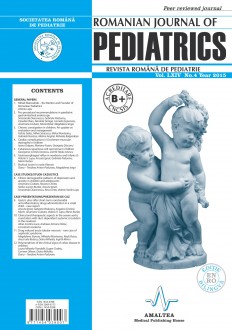SELECT ISSUE

Indexed

| |

|
|
|
| |
|
|
|

|
|
|
|
|
|
|
HIGHLIGHTS
National Awards “Science and Research”
NEW! RJP has announced the annually National Award for "Science and Research" for the best scientific articles published throughout the year in the official journal.
Read the Recommendations for the Conduct, Reporting, Editing, and Publication of Scholarly work in Medical Journals.
The published medical research literature is a global public good. Medical journal editors have a social responsibility to promote global health by publishing, whenever possible, research that furthers health worldwide.
DERMATITA ATOPICA – DISFUNCTIA IMUNA ASOCIATA ATOPIEI
Sempronia Ecaterina Coclici, Dana Elena Mîndru, Vasile Valeriu Lupu, Evelina Moraru and Laura Iulia Bozomitu
REZUMAT
Sistemul imunitar joacă un rol complex în apărarea organismului ca răspuns la „non-self“, răspunde anormal la antigenii alergeni (hipersensibilitate şi autoimunitate) şi este caracterizat prin toleranţă imună cu lipsa de reactivitate la propriile structuri (auto).
Scop. Scopul acestui studiu este de a demonstra că, în dermatita atopică, deficitul imun influenţează dezvoltarea atopiei, severitatea bolii şi dezvoltarea de comorbidităţi.
Material şi metode. În urma analizei foilor de observaţie, 135 de cazuri diagnosticate cu AD au fost incluse în studiu. Analiza statistică a fost realizată cu ajutorul SPSS V20 pentru determinarea frecvenţei şi testarea ipotezelor, pentru p <0,05, prin testele T şi OneWay ANOVA.
Rezultate. Din cele 135 de cazuri, 51,9% au fost copii de sex masculin şi 48,1% de copii de sex feminin, cu vârsta cuprinsă între 1 lună şi 127 luni, cu o medie de 26,21. Potrivit IgE serice totale, 64,4% dintre pacienţi au avut niveluri ridicate de IgE, 35,6% niveluri normale. În conformitate cu SCORAD, copiii au avut forma uşoară în 20,7% din cazuri, forma moderată în 70,4%, iar severă în 8,9% din cazuri. Deficitul de IgA a fost găsit în 48,1% din cazuri, iar deficitul de IgG a fost găsit în 38,5% din cazuri. Testele t de corelaţie pe eşantioane independente constată valori semnificative statistic între nivelul IgE şi deficitul de IgA, între SCORAD şi deficitul de IgG şi IgA. Marşul atopic este influenţat de valorile crescute ale IgE şi deficitul de IgA pentru un p<0,05.
Concluzii. Atopia în DA poate fi influenţată de factori complecşi, atât interni, cât şi de mediu, dar acest lucru rămâne un subiect controversat. Factorii externi care acţionează pe un fundal genetic predispus la atopie poate declanşa manifestarea DA.
Cuvinte cheie: dermatită atopică, deficit imun, IgE, IgA, IgG
